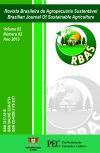EFFECT OF SILICON, NITROGEN AND POTASSIUM IN THE INCIDENCE OF TOMATO PIN WORM IN INDUSTRIAL TOMATO PLANTS
DOI:
https://doi.org/10.21206/rbas.v3i2.213Abstract
The tomato crop is exposed to many pests that limit yield. The aim of this research was to evaluate silicon, nitrogen and potassium effect on tomato pinworm injuries in tomato plants. The experiment was carried out under field conditions at, Brasília (DF), Brazil, in a completely randomized design, with 14 treatments (control - no fertilization; 2, 4, 6 and 8 kg.ha-1 of SiO2 applied on leaves surface; 60, 120, 180 e 240 kg.ha-1 of nitrogen; 100, 200, 300 e 400 kg.ha-1 of K2O; NPK according to soil analyses), in three tomato genotypes (‘Viradoro’,‘Tospodoro’ and ‘HEI 035’) in four replicates, in a total of 168 plots. The number of leaf mines was evaluated in ten plants per replicate, considering the third leaf from the top of two stems per plant. It was observed a decrease in the number of pinworm leaf mines with an increase in silicon and potassium doses and an increase in the number of mines with an increase on nitrogen doses.Downloads
Download data is not yet available.
Downloads
Published
2013-12-30
How to Cite
Marília Cristina dos Santos2*, Ana Maria Resende junqueira2, & Luciana Morais de Freitas2. (2013). EFFECT OF SILICON, NITROGEN AND POTASSIUM IN THE INCIDENCE OF TOMATO PIN WORM IN INDUSTRIAL TOMATO PLANTS. Brazilian Journal of Sustainable Agriculture, 3(2). https://doi.org/10.21206/rbas.v3i2.213
Issue
Section
Artigos
License
1. Proposta de Política para Periódicos de Acesso Livre
Autores que publicam nesta revista concordam com os seguintes termos:
Autores mantém os direitos autorais e concedem à revista o direito de primeira publicação, com o trabalho simultaneamente licenciado sob a Licença Creative Commons Attribution que permite o compartilhamento do trabalho com reconhecimento da autoria e publicação inicial nesta revista.












